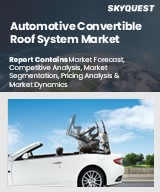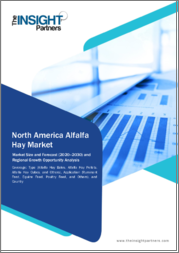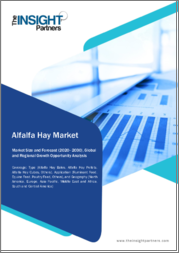
|
시장보고서
상품코드
1627691
알팔파 건초 시장 : 예측(2025-2030년)Alfalfa Hay Market - Forecasts from 2025 to 2030 |
||||||
알팔파 건초 시장의 2025년 시장 규모는 185억 8,500만 달러로 추정되며, 2030년에는 234억 2,300만 달러에 달할 것으로 예상되며, CAGR은 4.74%입니다.
알팔파 건초 시장의 주요 촉진요인은 축산업, 특히 낙농 및 육류 생산에서 고품질 사료에 대한 수요 증가이며, 알팔파의 고단백질 및 영양 성분은 동물의 최적의 건강과 생산성을 지원합니다. 전 세계 가축 사육두수 증가와 효율적인 동물 영양에 대한 관심이 높아지면서 수요가 증가하고 있습니다.
세계 농업은 그 어느 때보다 식량 안보를 보장해야 하는 사명을 띠고 있습니다. 세계 인구는 2009년부터 2050년까지 23억 명이 증가할 것으로 예상됩니다. 인구 증가는 주로 개발도상국의 개발로 인해 발생할 것으로 예상되며, 사하라 이남 아프리카는 114% 증가로 가장 빠른 성장률을 보일 것으로 예상됩니다. 반면, 동아시아 및 동남아시아의 성장률은 가장 느린 13% 증가율을 보일 것으로 예상됩니다. 또한 2050년에는 세계 인구의 70%을 도시 지역이 차지할 것으로 예상되며, 이는 현재 49%에서 증가할 것으로 추정됩니다.
또한, 2050년 1인당 소득은 현재의 몇 배에 달할 것으로 예측됩니다. 유엔식량농업기구(FAO)가 지적한 바와 같이, 2050년 91억 명의 인구를 먹여 살리려면 2005/07년부터 2050년 사이에 전체 식량 생산량을 약 70% 끌어올려야 합니다.
육류, 유제품, 생선, 양식 제품에 대한 수요 증가는 개발도상국 농업 GDP의 30%를 차지하는 축산업의 확대를 촉진할 것입니다. 개발도상국의 구매력 향상은 식생활 선호도 변화를 가져와 동물성 식품에 대한 선호도가 높아지고 식물성 주식에서 멀어질 것으로 예상됩니다.
또한, 전체 육류 소비는 예상 세계 성장률 중 82%를 차지할 것으로 예상됩니다. 중국과 브라질을 필두로 한 중남미 카리브해 지역과 아시아태평양이 향후 10년간 OECD 국가들의 성장률을 상회하는 성장의 대부분을 차지할 것으로 예상됩니다. 역량 개발, 농업 개선, 현대화 및 집약화된 생산 기술의 통합 증가가 이들 국가들의 성장에 촉매제가 될 것으로 예상됩니다.
브라질, 중국, 인도 및 독립국가연합(CIS) 국가들에서 가금류 부문은 어느 정도 위의 내용을 증명하고 있습니다. 또한, 가축은 전 세계 농가의 약 절반이 유기농 비료의 공급원이며, 유기농 식품에 대한 수요 증가에 대응할 수 있게 해준다는 점에 주목할 필요가 있습니다.
세계 알팔파 건초 시장의 지리적 전망:
- 예측 기간 동안 아시아태평양은 알팔파 건초 시장에서 큰 점유율을 차지할 것으로 예상됩니다.
아시아태평양은 육류 수출 증가로 인해 알팔파 건초 시장에서 큰 비중을 차지할 것으로 예상됩니다. 예를 들어, China International Import Expo Bureau, National Exhibition and Convention Centre(Shanghai)에 따르면, 중국은 2024년 쇠고기 수입 다변화를 위한 노력을 강화하고 있으며, 호주, 러시아 등의 국가에서 중국으로의 쇠고기 판매를 승인받은 수출업체가 증가하고 있습니다. 중국으로의 쇠고기 판매가 승인되는 수출업체가 증가하고 있습니다. 중국 관측통에 따르면, 이는 특정 시장에 대한 과도한 의존으로 인한 시장 변동을 억제하는 한편, 높은 수준의 개방을 통해 다른 나라에 더 많은 기회를 제공할 수 있다고 합니다.
또한, 원유 생산량의 증가는 향후 몇 년 동안 시장 성장에 긍정적인 영향을 미칠 것으로 예상됩니다. 예를 들어, 유엔식량농업기구(FAO)에 따르면 세계 원유 생산량은 지난 30년간 77% 이상 증가했으며, 1992년 5억 2,400만 톤에서 2022년에는 9억 3,000만 톤으로 증가할 것으로 예상하고 있습니다. 인도는 세계 최대 원유 생산국으로 세계 생산량의 약 22%를 차지하고 있으며, 미국, 파키스탄, 중국, 브라질이 그 뒤를 잇고 있습니다.
이 보고서를 구매해야 하는 이유
- 통찰력 있는 분석 : 고객 부문, 정부 정책 및 사회경제적 요인, 소비자 선호도, 산업별, 기타 하위 부문에 초점을 맞추고 주요 지역뿐만 아니라 신흥 지역까지 포괄하는 상세한 시장 인사이트를 얻을 수 있습니다.
- 경쟁 상황 : 세계 주요 기업들이 채택하고 있는 전략적 전략을 이해하고, 적절한 전략을 통한 시장 침투 가능성을 파악할 수 있습니다.
- 시장 촉진요인과 미래 동향 : 역동적인 요인과 매우 중요한 시장 동향, 그리고 이들이 향후 시장 발전을 어떻게 형성할 것인지에 대해 알아봅니다.
- 실행 가능한 제안 : 역동적인 환경 속에서 새로운 비즈니스 스트림과 수익을 발굴하기 위한 전략적 의사결정에 인사이트를 활용합니다.
- 다양한 사용자에 대응 : 스타트업, 연구기관, 컨설턴트, 중소기업, 대기업에 유익하고 비용 효율적입니다.
어떤 용도로 사용되는가?
산업 및 시장 인사이트, 사업 기회 평가, 제품 수요 예측, 시장 진입 전략, 지리적 확장, 설비 투자 결정, 규제 프레임워크와 영향, 신제품 개발, 경쟁의 영향
분석 범위
- 과거 데이터 및 예측(2022-2030년)
- 성장 기회, 도전과제, 공급망 전망, 규제 프레임워크, 고객 행동, 트렌드 분석
- 경쟁사 포지셔닝, 전략 및 시장 점유율 분석
- 매출 성장률 및 예측 분석 : 부문별/지역별(국가별)
- 기업 프로파일링(전략, 제품, 재무정보, 주요 동향 등)
목차
제1장 소개
- 시장 개요
- 시장 정의
- 분석 범위
- 시장 세분화
- 통화
- 가정
- 기준 연도와 예측 연도 타임라인
- 이해관계자에 대한 주요 이점
제2장 분석 방법
- 분석 디자인
- 분석 프로세스
제3장 주요 요약
- 주요 조사 결과
- 애널리스트의 견해
제4장 시장 역학
- 시장 성장 촉진요인
- 포장 수요 증가
- 지속가능성에 대한 주목 상승
- 시장 성장 억제요인
- 환경 문제
- 높은 생산 비용
- Porter's Five Forces 분석
- 업계 밸류체인 분석
제5장 알팔파 건초 시장 : 제품 종류별
- 소개
- 베일
- 큐브
- 펠릿
제6장 알팔파 건초 시장 : 용도 종류별
- 소개
- 유제품·육류 사료
- 말용 사료
- 가금류 사료
- 기타
제7장 알팔파 건초 시장 : 유통 채널별
- 소개
- 온라인
- 오프라인
제8장 알팔파 건초 시장 : 지역별
- 북미
- 미국
- 캐나다
- 멕시코
- 남미
- 브라질
- 아르헨티나
- 기타
- 유럽
- 독일
- 영국
- 프랑스
- 스페인
- 기타
- 중동 및 아프리카
- 이집트
- 사우디아라비아
- 남아프리카공화국
- 기타
- 아시아태평양
- 일본
- 중국
- 한국
- 인도
- 인도네시아
- 호주
- 태국
- 기타
제9장 경쟁 환경과 분석
- 주요 기업과 전략 분석
- 시장 점유율 분석
- 기업 인수합병(M&A), 합의, 사업 협력
- 경쟁 대시보드
제10장 기업 개요
- Barr-Ag Ltd.
- Cubeit Hay Company
- Alf Nutricao Animal
- Al Dahra Acx, Inc.
- Hill Top Farmers
- Alfalfa Monegros S.L.
- Gruppo Carli
- Forbes Lucerne
- Sl Follen Company
- Border Valley Trading
The alfalfa hay market is estimated to be valued at US$18.585 billion in 2025 and is expected to reach US$23.423 billion by 2030, with a CAGR of 4.74%.
A key driver for the alfalfa hay market is the increasing demand for high-quality forage in livestock industries, particularly in dairy and meat production, where alfalfa's high protein and nutrient content support optimal animal health and productivity. Increasing global livestock populations and a growing focus on efficient animal nutrition boost demand.
The global agriculture industry is tasked with ensuring food security more than ever. The world population is expected to grow by 2.3 billion people between 2009 and 2050. Population growth is projected to be primarily driven by developments in developing nations, with sub-Saharan Africa expected to see the fastest growth rate at +114%. In contrast, East and South East Asia are anticipated to experience the slowest growth at +13%. Further, urban areas are estimated to account for 70% of the global population in 2050, up from 49% at present.
Additionally, the per capita income in 2050 is projected to be a multiple of current levels. As the Food and Agriculture Organization (FAO) of the United Nations noted, feeding a population of 9.1 billion people in 2050 would require raising overall food production by some 70% between 2005/07 and 2050.
The projected growth in demand for meat, dairy, fish, and aquaculture products will drive the expansion of livestock farming, which currently accounts for 30% of agricultural GDP in the developing world. The increased purchasing power in developing nations is expected to result in a change in dietary preferences, which would be increasingly oriented towards animal-source foods and away from staple foods of vegetal origin.
Moreover, of the projected global growth, overall meat consumption is expected to account for 82% of it. The APAC region, led by China and the LACs, with Brazil at the forefront, is projected to account for most of the expansion, surpassing the growth in OECD countries over the next decade. Capacity building, improved agriculture, and increasing integration of modernized and intensive production technologies are expected to catalyze the growth in these countries.
To a certain extent, the poultry sector is a testimony to the aforesaid in Brazil, China, and India, as well as with the Commonwealth of Independent States (CIS) countries. Further, it should be noted that livestock is a source of organic fertilizer for approximately half of the world's farmers, enabling them to respond to the growing demand for organically produced food products.
Global Alfalfa Hay Market Geographical Outlook:
- The APAC region is poised to hold a substantial share of the alfalfa hay market in the forecasted period.
The APAC region is poised to hold a substantial share of the alfalfa hay market, owing to the rising meat exports. For instance, according to the China International Import Expo Bureau, National Exhibition and Convention Centre (Shanghai), China has stepped up efforts on diversifying beef imports in 2024, with more exporters in countries such as Australia and Russia being approved to sell beef to China. Chinese observers said that this will help reduce market fluctuations due to over-reliance on any single market while providing more opportunities for other countries through high-level opening-up.
Furthermore, increasing milk production is anticipated to positively influence market growth in the coming years. For instance, according to the Food and Agriculture Organization of the United States (FAO), global milk production has increased by more than 77% in the last three decades. From 524 million tonnes in 1992, it had risen to 930 million tonnes in 2022. India is the world's largest milk-producing country, accounting for around 22% of world production, followed by the United States of America, Pakistan, China, and Brazil.
Reasons for buying this report:-
- Insightful Analysis: Gain detailed market insights covering major as well as emerging geographical regions, focusing on customer segments, government policies and socio-economic factors, consumer preferences, industry verticals, other sub- segments.
- Competitive Landscape: Understand the strategic maneuvers employed by key players globally to understand possible market penetration with the correct strategy.
- Market Drivers & Future Trends: Explore the dynamic factors and pivotal market trends and how they will shape up future market developments.
- Actionable Recommendations: Utilize the insights to exercise strategic decision to uncover new business streams and revenues in a dynamic environment.
- Caters to a Wide Audience: Beneficial and cost-effective for startups, research institutions, consultants, SMEs, and large enterprises.
What do businesses use our reports for?
Industry and Market Insights, Opportunity Assessment, Product Demand Forecasting, Market Entry Strategy, Geographical Expansion, Capital Investment Decisions, Regulatory Framework & Implications, New Product Development, Competitive Intelligence
Report Coverage:
- Historical data & forecasts from 2022 to 2030
- Growth Opportunities, Challenges, Supply Chain Outlook, Regulatory Framework, Customer Behaviour, and Trend Analysis
- Competitive Positioning, Strategies, and Market Share Analysis
- Revenue Growth and Forecast Assessment of segments and regions including countries
- Company Profiling (Strategies, Products, Financial Information, and Key Developments among others)
The Alfalfa Hay market is segmented and analyzed as follows:
By Product Type
- Bales
- Cubes
- Pellets
By Application Type
- Dairy/Meat animal feed
- Horse Feed
- Poultry Feed
- Others
By Distribution Channel
- Online
- Offline
By Geography
- North America
- USA
- Canada
- Mexico
- South America
- Brazil
- Argentina
- Others
- Europe
- Germany
- UK
- France
- Others
- Middle East and Africa
- Egypt
- Saudi Arabia
- South Africa
- Others
- Asia Pacific
- Japan
- China
- South Korea
- India
- Indonesia
- Australia
- Thailand
- Others
TABLE OF CONTENTS
1. INTRODUCTION
- 1.1. Market Overview
- 1.2. Market Definition
- 1.3. Scope of the Study
- 1.4. Market Segmentation
- 1.5. Currency
- 1.6. Assumptions
- 1.7. Base and Forecast Years Timeline
- 1.8. Key benefits for the stakeholders
2. RESEARCH METHODOLOGY
- 2.1. Research Design
- 2.2. Research Process
3. EXECUTIVE SUMMARY
- 3.1. Key Findings
- 3.2. Analyst View
4. MARKET DYNAMICS
- 4.1. Market Drivers
- 4.1.1. Growing Demand for Packaging
- 4.1.2. Increasing Focus on Sustainability
- 4.2. Market Restraints
- 4.2.1. Environmental Concerns
- 4.2.2. High Production Cost
- 4.3. Porter's Five Forces Analysis
- 4.3.1. Bargaining Power of Suppliers
- 4.3.2. Bargaining Power of Buyers
- 4.3.3. The Threat of New Entrants
- 4.3.4. Threat of Substitutes
- 4.3.5. Competitive Rivalry in the Industry
- 4.4. Industry Value Chain Analysis
5. ALFALFA HAY MARKET BY PRODUCT TYPE
- 5.1. Introduction
- 5.2. Bales
- 5.3. Cubes
- 5.4. Pellets
6. ALFALFA HAY MARKET BY APPLICATION TYPE
- 6.1. Introduction
- 6.2. Dairy/Meat animal feed
- 6.3. Horse Feed
- 6.4. Poultry Feed
- 6.5. Others
7. ALFALFA HAY MARKET BY DISTRIBUTION CHANNEL
- 7.1. Introduction
- 7.2. Online
- 7.3. Offline
8. ALFALFA HAY MARKET BY GEOGRAPHY
- 8.1. North America
- 8.1.1. USA
- 8.1.2. Canada
- 8.1.3. Mexico
- 8.2. South America
- 8.2.1. Brazil
- 8.2.2. Argentina
- 8.2.3. Others
- 8.3. Europe
- 8.3.1. Germany
- 8.3.2. UK
- 8.3.3. France
- 8.3.4. Spain
- 8.3.5. Others
- 8.4. Middle East and Africa
- 8.4.1. Egypt
- 8.4.2. Saudi Arabia
- 8.4.3. South Africa
- 8.4.4. Others
- 8.5. Asia Pacific
- 8.5.1. Japan
- 8.5.2. China
- 8.5.3. South Korea
- 8.5.4. India
- 8.5.5. Indonesia
- 8.5.6. Australia
- 8.5.7. Thailand
- 8.5.8. Others
9. COMPETITIVE ENVIRONMENT AND ANALYSIS
- 9.1. Major Players and Strategy Analysis
- 9.2. Emerging Players and Market Lucrativeness
- 9.3. Mergers, Acquisitions, Agreements, and Collaborations
- 9.4. Vendor Competitiveness Matrix
10. COMPANY PROFILES
- 10.1. Barr-Ag Ltd.
- 10.2. Cubeit Hay Company
- 10.3. Alf Nutricao Animal
- 10.4. Al Dahra Acx, Inc.
- 10.5. Hill Top Farmers
- 10.6. Alfalfa Monegros S.L.
- 10.7. Gruppo Carli
- 10.8. Forbes Lucerne
- 10.9. Sl Follen Company
- 10.10. Border Valley Trading















